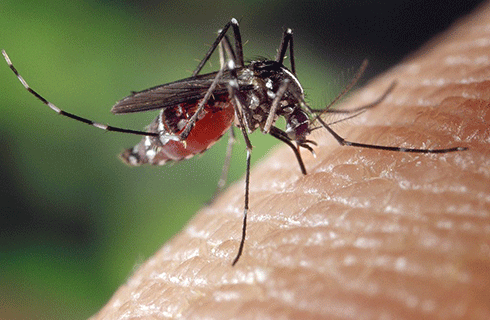
|
Published: 26 August 2013
Disease-carrying Asian tiger within biting distance of Australia
Scientists have identified the presence of a mosquito associated with transmission of the tropical diseases dengue fever and chikungunya just 30 kilometres north of Queensland.

|
|
A blood-engorged female Aedes albopictus mosquito feeding on a human host. Credit: Center for Disease Control and Prevention
|
Researcher Dr Nigel Beebe, from the University of Queensland and CSIRO, said established populations of the Asian tiger mosquito had been found on the Torres Strait islands of Waiben (Thursday) and Ngurupia Horn), in the southern Torres Strait, just off Cape York Peninsula.
He said there was no clearly marked frontier between Papua New Guinea and northern Australia, and it was difficult to ensure that people and boats were not accompanied by mosquitos carrying deadly viruses like dengue and chikungunya.
‘Once on the mainland, the Asian tiger mosquito is highly capable of travelling with humans and establishing as far south as Tasmania,’ Dr Beebe said.
‘It is capable of transmitting both dengue and chikungunya throughout northern and southern urban landscapes in the summer months,’ he said.
‘We need to be completely on the front foot here, aggressively developing technologies to shut down the risk of an Asian tiger mosquito expansion into Australia, while establishing contingency plans for its arrival.’
Dr Beebe led a team of researchers which quantified the population genetics of the tiger mosquito and found it did not come from PNG, as first thought, but from the Indonesian region, and most likely through illegal fishing in the region.
The study, published in PLOS, found that there were already regular appearances of the Asian tiger mosquito at Australia's northern mainland ports, with boat travel between the islands being the most likely cause.
‘With climate change, and the potential invasion of the tiger mosquito into our urban landscapes, the risk of dengue and chikungunya virus transmission is likely to increase in Australia, due to changing temperatures as well as the increased use of rain water tanks and other water storage facilities,’ Dr Beebe said.
The study was funded by The University of Queensland, the CSIRO Climate Adaptation Flagship and the Australian Biosecurity Cooperative Research Centre for Emerging Infectious Disease.
Source: UQ



